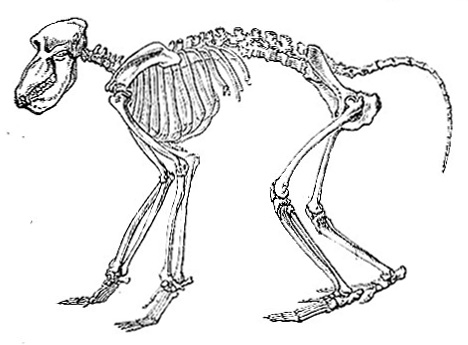1902 Encyclopedia > Ape > Ape Skeleton - Caudal Vertebrae; Metapophyses; Anapophyses; Sternum; Ribs; Thorax.
Ape
(Part 18)
<
(C) The Anatomy of Apes (cont.)
Ape Skeleton - Caudal Vertebrae; Metapophyses; Anapophyses; Sternum; Ribs; Thorax.
The caudal vertebrae are always more than four in number, except in the Simiinae and in Macacus inuus. In Cynocephalus mormon (the mandrill), however, there are sometimes only five vertebrae. The short-tailed Macaci and Brachyuri have from about fifteen to seventeen caudal vertebrae, the shortness of the tail being occasioned rather by a diminution in the size of the component vertebrae than by a decrease in their number. In the other forms the number varies between twenty and thirty-three, the latter being the number attained in the genus Ateles. The proportion borne by this region of the spine to all the more anterior parts is greatest in Ateles, almost three to one; in the other longest-tailed genera it is rarely so large as two to one. The absolute length of the tail is greatest in the Semnopithecinae, where also the individual caudal vertebrae attain their greatest length, namely, two inches. The caudal vertebrae generally increase in length as we proceed backwards from the sacrum, till about the seventh, eight, or ninth, which, with the tenth and eleventh, are the longest caudal vertebrae in most long-tailed forms. In Ateles, however, it is the eleventh, twelfth, thirteenth, and fourteen vertebrae that are the longest. In the Simiinae and in Inuus the caudal vertebrae decrease in length as we proceed backwards. Except in the forms just named, all the first four caudal vertebrae possess a complete neutral arch, sometimes six are so provided, but only in Ateles does the number attain eight. With the same exceptions, again, the first four caudal vertebrae unite by articular processes, while transverse processes (single or antero-posteriorly double) exist in a great part of the tail. In Ateles the caudal vertebrae are (as might be expected from the very prehensile character of the tail) exceptionally provided with bony processes serving as points of muscular attachment. Chevron bones and processes for their attachment are altogether wanting only in the Simiinae and in Macacus inuus. They attain their maximum in Ateles, where they present almost every variety of development in one or other part of the caudal region.

Fig. 18 -- Skeleton of Chacma Baboon (Cynocephalus porcarius). From De Blainville.
Certain vertebral processes, which in man are generally inconspicuous, and which are but little developed in the Simiinae, attain in lower forms a marked development. These are the metaphophyses and anapophyses. The first of these generally appear about the eight or ninth dorsal vertebrae, and may thence be traced backwards into the anterior caudal vertebrae, where they end by coalescing with the prezygopophyses. In Ateles these processes may sometimes be traced as far forward as the third cervival vertebra. The anapophyses become, below the Simiinae, very conspicuous, projecting outwards and backwards from one vertebra, and embracing the prezygophyphysis of the vertebra next behind. Generally they may be traced from the eight or ninth dorsal vertebra to the penultimate lumbar vertebra. They attain their maximum of relative size in the lower Cebidae. They may (as sometimes in Ateles abd Cynocephalus) be traced on to the posterior cervical vertebrae, while they appear to coalesce with the transverse processes in the tail, and thus they may be developed almost throughout the vertebral column. The Cebidae often develop hyperapophyses in the last dorsal and in the lumbar vertebrae. These processes are some what similar to anapophyses, but are placed much higher, and each pair embraces the spinous process of the vertbera next behind.
In most apes the sternum is quite narrow, and consists of a more or less enlarged manubrium, followed by a chain of sub-equal and antero-posteriorly elongated bones from three to six in number. In the Simiinae alone do we find a broad sternum, or one consisting of a manubrium, followed by one bone only, as in Hylocates. The orang present a singular peculiarity, in that the breast-bone long remains made up of oassifications arranged in pairs, side by side, successively.
The total number of ribs has already been indicated in speaking of the dorsal vertebrae. The true ribs are seven in number on each side in the highest forms, but in Hylobates there are sometimes eight. In Ateles there are sometimes nine pairs. In Hapale the number varies from six to eight, and it is seven or eight in the other genera. The "angles" of the ribs are never so marked as in man. They are most marked in Hylobates. Pithecia is distinguished by the greater relative breadth of the ribs.
In no ape is the thorax half as broad again as it is deep from back to breast. Nevertheless, in the Simiinae, its transverse diameter exceeds its depth by both about one-fourth to a little under one-third of the latter. In Ateles (and sometimes also in Mycetes) the thorax is wider than it is deep, but in all the rest it is narrow, being deeper than it is wide.
Read the rest of this article:
Ape - Table of Contents
|
